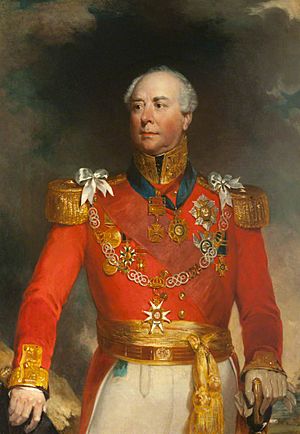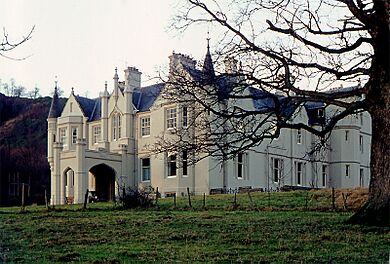Sir Archibald Campbell, 1st Baronet facts for kids
Quick facts for kids
Sir
Archibald Campbell
|
|
|---|---|

Portrait by John Wood
|
|
| Born | 12 March 1769 Glen Lyon |
| Died | 6 October 1843 Edinburgh |
| Buried | |
| Allegiance | United Kingdom |
| Service/ |
British Army Portuguese Army |
| Years of service | 1787–1843 (Britain) 1813–1820 (Portugal) |
| Rank | General (Britain) Major-General (Portugal) |
| Commands held | 71st Regiment of Foot 6th Portuguese Infantry Regiment 38th Regiment of Foot |
| Battles/wars | |
| Awards | Army Gold Cross Military Order of the Tower and Sword (Portugal) |
| Alma mater | Tonbridge School |
Sir Archibald Campbell (born March 12, 1769 – died October 6, 1843) was a brave Scottish soldier. He became a high-ranking general in the British Army. From 1824 to 1826, General Campbell led the British forces in the First Anglo-Burmese War. This was a very long and costly war in British India. It helped Britain gain control of several areas like Assam and Arakan.
He became known as the "Hero of Ava" because of his success. Later, from 1831 to 1837, he was the leader of the New Brunswick colony in Canada. A city in Canada, Campbellton, was named after him.
Contents
Early Life and Education
Archibald Campbell was born on March 12, 1769, in a place called Glen Lyon in Scotland. He went to school at Tonbridge School in England. His father was Captain Archibald Campbell. His family had connections to important Scottish families.
A Soldier's Journey: Military Career
Archibald Campbell started his army career at age 18 in 1787. He was an ensign, which is a junior officer.
First Adventures in India
In 1788, he went to India with his regiment. He took part in battles against a ruler named Tipu Sultan in 1790. He was promoted to Lieutenant in 1791. He also fought in the first siege of Seringapatam. This was an important city in India.
In 1795, his regiment helped take over a Dutch fort in Cochin. Later, in 1799, he helped take control of the island of Ceylon.
Fighting in Europe
After getting sick, he returned home in 1801. In 1805, he went to Portugal with his new regiment. He fought in several important battles during the Napoleonic Wars, including Roliça, Vimeiro, and Corunna.
In 1809, he became a lieutenant-colonel. He helped organize the Portuguese army. He was promoted to full colonel and then brigadier. He was involved in most of the fighting in the Iberian Peninsula (Spain and Portugal).
By 1813, Campbell was a major-general in the Portuguese army. He returned to British service in 1820. For his service in these wars, he received the Army Gold Cross.
Leading the First Anglo-Burmese War (1824–1826)
In India, General Campbell was chosen to lead a large British force against the Burmese. This was the First Anglo-Burmese War.
Taking Yangon (1824)
In May 1824, he led over 10,000 soldiers to Yangon (Rangoon). They took the city easily because it was empty. Campbell then made the Shwedagon Pagoda compound a strong base. He launched attacks and pushed the Burmese back.
In December 1824, Campbell and his men won a big victory in Yangon. They defeated a much larger Burmese army. Thousands of Burmese soldiers were lost. The Burmese army then retreated to Danubyu.
Controlling Lower Burma (1825)
In March 1825, Campbell sent a force to take Danubyu. The fort was strongly defended, but it fell after the Burmese general, Maha Bandula, was killed. After this, the British took Pyay (Prome). They then secured control of Lower Burma.
In late 1825, Campbell's forces successfully stopped the Burmese from trying to retake Pyay.
Marching to Victory (1826)
With the Burmese army weakened, Campbell marched north. He took the ancient capital of Pagan (Bagan) in February 1826. When his forces reached Yandabo, close to the Burmese capital Ava, the Burmese finally agreed to a peace treaty.
Campbell was the main British person to sign the Treaty of Yandabo. This treaty ended the war. The Burmese gave up several areas to the British. They also had to pay a large amount of money. This war was very costly for both sides. Many soldiers died, and it caused money problems for British India.
After the War
After the war, Campbell was thanked by the British Parliament. He also received a gold medal and a yearly pension. In 1839, he became the Commander-in-chief in Bombay, India, but he had to leave due to poor health.
Serving as Lieutenant-Governor
Campbell returned to England in 1829. In 1831, he became the Lieutenant Governor of New Brunswick in Canada. He stayed there for six years.

Campbell was worried about the safety of New Brunswick. He started building a road called the "Royal Road." This road went from Fredericton to Grand Falls. It was meant to help move troops quickly if there was a threat from the Americans. The city of Campbellton in New Brunswick was named in his honor.
He continued to hold important military positions until his death.
Family Life

Archibald Campbell married Helen MacDonald in 1801. They had two sons and three daughters. Both Archibald and Helen spoke Gaelic. Their main home was Garth House in Scotland.
One of his sons-in-law was Lieutenant Colonel John James Snodgrass. Another was General Sir Augustus Almeric Spencer.
Sir Archibald Campbell died in Edinburgh on October 6, 1843, at age 74. He was buried in the churchyard of St John the Evangelist in Edinburgh. His son, Sir John Campbell, 2nd Baronet, took over his title.
Awards and Honors
Sir Archibald Campbell received several important awards for his service:
- He was made a Commander of the Portuguese Order of the Tower and Sword in 1813.
- He became a Knight Bachelor in 1814.
- He received the Order of the Bath in 1815 and was made a Knight Grand Cross in 1826.
- He was awarded the title of Baronet Campbell of New Brunswick in 1831.
Images for kids


